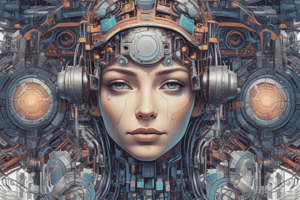Podcast
Questions and Answers
What is the primary goal of AI?
What is the primary goal of AI?
- To process and analyze large datasets
- To mimic human-like intelligence in machines
- To develop algorithms for specific tasks
- To simulate human reasoning and decision-making (correct)
What enables ML systems to make predictions and classifications?
What enables ML systems to make predictions and classifications?
- Human input and supervision
- Random guesses and probability
- Pattern recognition from data (correct)
- Pre-set rules and algorithms
How do AI systems handle new situations?
How do AI systems handle new situations?
- They become slower and less efficient
- They adapt and learn from experience (correct)
- They require human intervention and reprogramming
- They follow pre-set rules and algorithms
What is the key difference between ML and AI?
What is the key difference between ML and AI?
What makes ML systems more accurate and efficient?
What makes ML systems more accurate and efficient?
What is the primary difference between ML and traditional AI systems?
What is the primary difference between ML and traditional AI systems?
What is a characteristic of Machine Learning (ML) systems?
What is a characteristic of Machine Learning (ML) systems?
What is a limitation of Artificial Intelligence (AI) systems?
What is a limitation of Artificial Intelligence (AI) systems?
What type of AI is designed for specific tasks?
What type of AI is designed for specific tasks?
What is a characteristic of building complex AI systems?
What is a characteristic of building complex AI systems?
What is a characteristic of Machine Learning (ML) algorithms?
What is a characteristic of Machine Learning (ML) algorithms?
Flashcards are hidden until you start studying
Study Notes
Machine Learning (ML) vs Artificial Intelligence (AI)
- ML is a subset of AI that involves developing algorithms and models to enable computers to learn from data.
- AI refers to the broader concept of creating machines or systems capable of performing tasks that typically require human intelligence.
Key Features of ML
- ML algorithms allow computers to improve their performance on a specific task by learning patterns from data.
- ML enables systems to make predictions, classifications, and decisions based on learned knowledge.
- ML systems learn from data and adapt their performance over time, becoming more accurate and efficient as they process more information.
Key Features of AI
- AI systems are designed to mimic human-like intelligence and adapt to new situations.
- AI systems can reason, comprehend, and learn from past experiences.
Applications of ML and AI
- ML applications: recommendation systems, fraud detection, image recognition, language translation, and predictive analytics.
- AI applications: robotics, natural language processing, expert systems, and autonomous vehicles.
Learning and Adaptation
- ML systems can adapt and learn independently from data.
- AI systems may require human intervention to update rules or adapt to new scenarios.
Data Dependency
- ML algorithms require significant amounts of data for training and improving accuracy.
- AI systems rely less on vast amounts of data and more on predefined rules and logic.
Types of ML and AI
- ML: supervised learning, unsupervised learning, and reinforcement learning.
- AI: narrow (or weak) AI (designed for specific tasks) and general (or strong) AI (aiming to mimic human cognitive functions).
Building Complex Systems
- ML allows complex models to be built by training on relevant data, without requiring explicit programming for every scenario.
- Building complex AI systems requires substantial programming, domain expertise, and manual intervention.
Studying That Suits You
Use AI to generate personalized quizzes and flashcards to suit your learning preferences.




